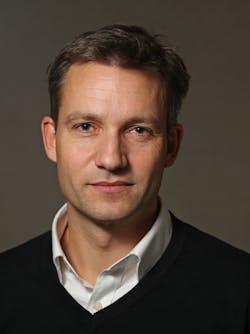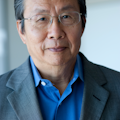Business Forum: Better bring a hands-on, customer-oriented attitude to photonics entrepreneurship

Professor Jes Broeng is a photonics entrepreneur; co-founder of Crystal Fibre (now NKT Photonics), Norlase, and Bifrost Communications; a professor at the Technical University of Denmark (DTU); a mentor for the Nordic Mentor Network for Entrepreneurship; and an angel investor. He is currently a visiting scholar in entrepreneurship and innovation sponsored to bridge the Technical University of Denmark (DTU) and UC Berkeley in the healthcare area. He is the recipient of the European Optics Prize in 1999, and the DTUs Innovation Prize 2016.
I encourage you to attend the workshop he and I will be conducting at CLEO 2017 along with three entrepreneurs who have successfully started photonics companies here and in Europe in recent years.
Milton Chang: Why are you at Berkeley?
Jes Broeng: My visit is to learn the culture and best practices that universities play in making Silicon Valley so successful in incubating startup companies. I am also here to establish links between American and Danish companies. It is interesting to note that three out of four European acquisitions are by U.S. companies.
MC: Why is that, in your opinion?
JB: Traditional European companies tend to focus and guard their core business. Our companies are efficient in fine-tuning quality and optimizing productivity, which is never going to come from the outside. That typically leaves European companies more risk-averse to early technology acquisitions. The flip side is whatever European companies do, they do—in general—very well.
MC: Germany is an exception, maybe due to efforts of the Fraunhofer Institute promoting industry-university collaboration?
JB: Yes, German companies are heavily involved in applied science in academia, in part due to the Fraunhofer organization. There are strong similar initiatives all across Europe—several countries, including Denmark, are increasingly interested in promoting entrepreneurship and encourage spinouts. A trend seems to be young researchers (as opposed to the established faculty) being a key to lead startups, in combination with experienced advisors or entrepreneurs from industry.
MC: What best practices do you wish to bring back?
JB: We do top research and have government grants to fund startups, but interaction between universities and successful entrepreneurs is lacking in part because Europeans are less mobile in migrating between industry and universities. Hence, I am here to study ways to institutionalize more open structures at the university to enable external people to play an active role in bringing research to benefit society via entrepreneurship.
Here, it is natural for successful entrepreneurs to come back and help the next generation forward. I see Americans being much more aware of the benefits to all in this giving back or "pay it forward" culture than in Europe. Hence, going back, I aim to create communities of experienced engineers and business people at DTU who will help the next generation of entrepreneurs.
MC: My sense is there is a great deal of interest in entrepreneurial activities now. Trumpf, for example, has recently formed a venture capital company. What drives that?
JB: Yes, times are changing. We see thriving startup hot spots all around Europe. From a technical perspective, information technology is disruptive even to traditional hardware industry. Investors are funding seed stage at historically high rates and politicians stimulate this further, as they are very aware that new companies create jobs, especially high-tech companies.
With a growing number of startups, large corporations are increasingly realizing that this is a significant force with opportunities for them, as well as threats that they need to pay attention to. Coming full circle is students entering universities, who are looking at successful entrepreneurs as role models.
I believe this is an opportunity also for the universities, as entrepreneurial activities provide additional resources and funding streams to fuel the academic research. We have seen some spectacular examples, such as my professor/mentor Anders Bjarklev, founder of Crystal Fibre, who is now the president of DTU.
MC: Aside from attitudes, what structural changes have also made a difference?
JB: There is never a shortage of government grants to support technology development in startup companies, but the process of getting grants is now less bureaucratic. For example, instead of having to provide four- to five-year detailed commercialization plans, a startup company can readily get small grants to get started and apply for a bigger grant once it shows initial traction.
It also made a difference that universities can now own the IP that results from government grant support. Then, there are events such as the decline of Nokia that resulted in making Helsinki a hotbed for startups. Globalization also plays into that, with companies like Google and Facebook setting up major development centers in Zürich, Paris, and several other sites in Europe. They have brought Silicon Valley culture to us.
MC: Any photonics startup that comes to the top of your mind?
JB: Norlase, Bifrost Communication, and FaunaPhotonics. They are all at an early stage and operate in med-tech, communications, and digital farming, respectively. These are companies that were all started from world-class research, where external entrepreneurs came in to play a leading role in the spinout.
What I see in these companies is an ability to focus fast on customers and engage in building commercial partnerships. This has also been noticed by investors, where all three have proven attractive and have secured strong third-party funding.
MC: How does DTU encourage entrepreneurship?
JB: We recruit successful entrepreneurs with domain knowledge in both business and technology to introduce them as change agents to work as volunteers to support our entrepreneurial activities. They engage with PhD students to build trust and rapport, and show them the reality of commercialization and feasibility to get them one step closer to commercialization.
It makes a difference, for example, to coach them to not undersell or oversell the opportunity when trying to get seed capital, and advise them to spend on operations, not on fixed assets.
What makes a big difference is when a university is willing to participate in commercialization activities, allowing university facilities to conduct commercialization research and development. Professors who are focused on world-class research are able to do so as never before.
MC: Tell me more about these volunteers.
JB: They are typically engineers who have gone into management, sales, or have worked for startup companies. They start as mentors and advisors to the research team, and wind up being co-founders, board members, and/or seed investors when the company is launched—and in several cases, they end up stepping into the startup full-time and taking an executive role. The result is we see more customer-focused spinouts and more successful commercialization.
MC: What is that one most significant thing you got out of your time at Berkeley?
JB: Entrepreneur mindset. Students are encouraged to go out to do market research, to talk to many customers, and build what they've learned into a business plan. In Europe, we are more theoretical and analytical—and believe we can teach entrepreneurship by going through the logics of, for example, patenting, financials, and elaborate business plans. Here, it's more hands-on and customer-oriented. I hope to do something with that approach.
About the Author
Milton Chang
MILTON CHANG of Incubic Management was president of Newport and New Focus. He is currently director of mBio Diagnostics and Aurrion; a trustee of Caltech; a member of the SEC Advisory Committee on Small and Emerging Companies; and serves on advisory boards and mentors entrepreneurs. Chang is a Fellow of IEEE, OSA, and LIA. Direct your business, management, and career questions to him at [email protected], and check out his book Toward Entrepreneurship at www.miltonchang.com.
